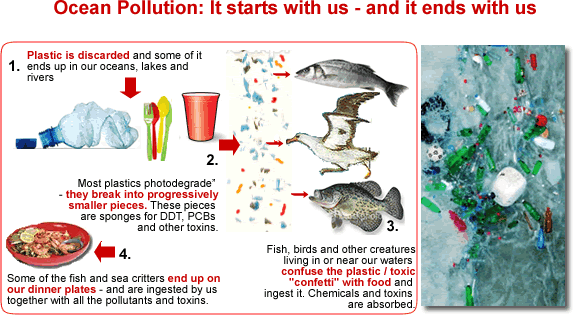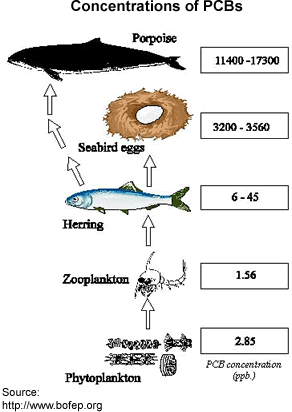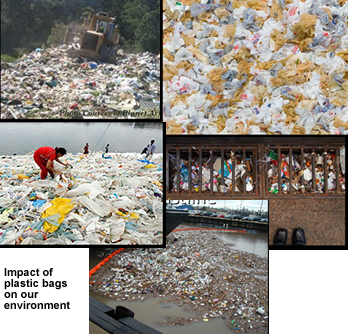
 What you can do to be part of the solution ....
What you can do to be part of the solution ....
Real & Potential Harm to our Ecosystem:
A study in 1975 showed that 8 million pounds of plastic were dumped into our oceans annually (~10% of which consisted of plastic shopping bags). Scientists note that the amount of plastic particles in the oceans has at least tripled since the 1960s. The Great Pacific or Eastern Garbage Patch is an area of marine debris in the central North Pacific Ocean that stretches across ~537,640 square miles or 1,392,400 km2 (about twice the size of Texas). This is literally a floating landfill where garbage concentrates in certain areas guided by circular ocean currents. This is only ONE such gyre -- there are 8 others that have become accumulation zones for plastic debris. Many link the following phenomenon to marine garbage ...
- Loss of Fish and all Life that Depends on Fish: 90% of worldwide stocks of tuna, cod, and other big fish have disappeared in the last 50 years. Both people and many animals depend on fish as a source of nutrition ...
Dr. Boris Worm of Dalhousie University in Nova Scotia. warns that unless major changes are implemented, we can expect to see the world’s oceans empty of commercial fish by 2048. The consequences for marine ecosystems could be devastating to the future of life across the world's oceans.
- A drastic increase of red tide as well as other toxic algae and bacteria in our oceans. The major effect of red tides is the associated wildlife mortalities among marine and coastal species of fish, birds, marine mammals, and other organisms.
- Increasingly acid seawater that is threatening fish, coral, and other marine life. Our oceans are turning into vinegar! 75 percent of all kelp forests have disappeared in the last 50 years
Chemicals found in many plastics act independently and together to adversely affect human, animal, and environmental health.
Effects on our wildlife ...
Floating garbage is polluting our world's oceans and coastlines, but it is also posing a serious threat to fish, seabirds, marine reptiles, and marine mammals. According to U.N. Secretary-General Kofi Annan, it is killing more than a million seabirds and 100,000 mammals and sea turtles each year.
Wildlife is injured or killed by entanglement or indigestion of plastics.
In the ocean, plastic pieces are easily mistaken for zooplankton and fish eggs (primary food sources for ocean life), and end up in the stomachs of fish, birds, and other ocean life.
- In April 2007, Dutch scientists released a report on litter in the North Sea and found that fulmars, a type of seagull, had an average of 30 pieces of plastic in their stomachs.
Plastic bags, bottle tops, and polystyrene foam coffee cups are often found in the stomachs of dead sea lions, dolphins, sea turtles, seabirds, and others.
- In samples taken from the gyre in 2001, the mass of plastic exceeded that of zooplankton (a primary food source) by a factor of seven. Scientists anticipate a 60:1 ratio by the year 2010.
Many people have seen photographs of seals trapped in nets or strangled by plastic six-pack rings, or sea turtles feeding on plastic shopping bags.
Besides ingestion and entanglement of wildlife, the floating debris can absorb persistent organic pollutants from seawater.
Hideshige Takada, an environmental geochemist at Tokyo University, and his colleagues have discovered that plastic polymers are sponges and couriers of waste chemicals called "persistent organic pollutants" or POPs, which include known carcinogens such as DDT, PCBs and other pollutants and toxins.
These toxins latch on to plastic polymers that are commonly used in consumer products and that are “photodegrading” in our environment (they break up into progressively smaller pieces - referred to as "nurdles").
When ingested, some of these are mistaken by the endocrine system as estradiol, causing hormone disruption.
As sealife mistakes the plastic pieces for food and ingest them, the chemicals and toxins in the plastic pass into the food web that may lead to our dinner table.
 The real and potential effect on humans ...
The real and potential effect on humans ...
The health of the air we breathe, the water we drink or bathe in, and the earth in which we grow our food has an immense effect on our health. A recent US Centers for Disease Control and Prevention study found that about 93 percent of the US population had bisphenol A, a chemical that can be found in canned goods and in hard, clear plastic items (including baby bottles) , in their body.
- Obesity: Scientists studying obesity are focusing on endocrine disrupters. Endocrine disruptors are ubiquitous in our environment and impact our health. Endocrine disruptor chemicals (EDC’s) are added to plastic products to make them softer and easier to handle.
These EDCs are common in our environment and, when absorbed by humans and wildlife, mimic the action of hormones and have been linked to reproductive problems in animals and humans are known to affect fat cells.
Bisphenol A (an endocrine disruptor) is a key monomer in production of polycarbonate plastic and epoxy resins. Polycarbonate plastic, which is clear and nearly shatter-proof, is used to make a variety of common products including baby and water bottles, sports equipment, medical and dental devices, dental composite (white) fillings and sealants and lenses. A study at the University of Missouri-Columbia showed that mice fed bisphenol A during early development — at lower amounts than what would have resulted in the levels found in most people in the CDC study — become markedly more obese as adults than those that weren't fed the chemical. Tufts University scientists observed similar phenomenon in rats.
Article: The Obesity Epidemic: Is Plastic Making Us Fat? By BETH DALEY - Scientists are concerned that the exposure to plastic alters the health and fertility of our children and even their children.
- Fetal exposure to BPA or PBDEs disrupts normal development of the brain and behavior in rats and mice.
- The hormonelike chemicals in plastic may remodel our cells and tissue during key stages of development - both in the womb and in early childhood.
- Observed is a significant increase in chromosomal abnormalities in the eggs forming in embryos

The Solution:
View and share this pdf file prepared by Stuart Greenfield. His research provides further information on this monumental problem and also has active links to very interesting videos and websites that cover this topic.
You can be part of the solution by being a role model to others, by educating your friends and those you meet on what is happening to our environment and how we are causing it by not thinking or caring about how our actions impact the environment and all living beings in it (including us) ... Simple things you can do ...
- Never accept plastic bags at the grocery store. Bring your own reusable bags with your “Green Living” message on it, which will let other people know that you care and are a responsible being.
- Lobby with your local politicians to have shopping bags banned!
- Click here to learn more about the impact and harm of plastic bags.
- Plastic water bottles don't only contain chemicals such as BPAs that cause cancer but are a huge burden on our environment. It’s so easy to buy one stainless or a reusable (BPA-free!!!!!) plastic bottle that you can use for years to come. You will save money as well! It makes sense …
- Avoid plastic cutlery and plastic plates.
- Insist on eliminating unnecessary packaging
- Recycle … recycle … recycle.
- What DOES NOT WORK: Biodegradable Plastics - they are treated with additives that are supposed to help the plastic break down faster. However, according to a recent study, But biodegradable plastics degraded no faster than untreated regular plastic.
The Algalita Marine Research Foundation - dedicated to the protection of the marine environment and its watersheds through research, education, and restoration - suggests the following:
- Create a 100% recyclable and compostable grocery list. Imagine all of your household waste going into the compost pile or recycle bin!
- If you must buy consumable products, choose paper, glass or bio-plastic.
- Ask your community to install screens over storm drains, and help keep them free of litter, leaves and debris.
The Destruction or Protection of our Environment is in Your Hands ...
References:
- Slides: http://www.poconorecord.com/apps/pbcs.dll/article?AID=/20080506/MULTIMEDIA02/80505016
- http://www.ktvu.com/news/10312783/detail.html - Plastic Waste Creating Ocean-Sized Crisis
My most heartfelt thanks to those people who have produced this important, eye-opening documentary that plays an important role in educating us and, hopefully, in slowly changing our behaviors to be more protective and thoughtful of the world we live in and the creatures we share it with ...
GreenAndHealthy.Info strives to maintain accurate and up-to-date information; however, mistakes do happen. If you would like to correct or update any of the information, please send us an e-mail. THANK YOU!
